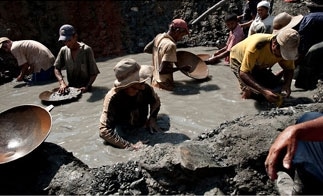Illicit gold mining has overtaken coca as the main source of funding for criminal organizations in at least eight Colombian provinces, according to a report.
According to a recently released study by the Toledo International Center for Peace (known by its Spanish acronym as CITpax), a Spanish conflict-analysis organization, illegal gold mining has overtaken coca production as the main source of income for armed groups in eight of Colombia’s 32 provinces (see map below). The report says that guerrillas and other armed groups in these provinces — Antioquia, Choco, Cordoba, Bolivar, Santander, Tolima, Valle del Cauca and Cauca — are taking advantage of a nationwide uptick in gold mining, extorting local mining endeavors and raking in bigger and bigger profits.
Colombia’s “gold rush” has been a boon for the coffers of guerrilla groups like the Revolutionary Armed Forces of Colombia (FARC) and National Liberation Army (ELN), as well as drug trafficking groups like the Rastrojos and Urabeños. CITpax estimates that 86 percent of all gold in the country is mined illegally, and that as much as 20 percent of the profits from these illegal endeavors go to the FARC, with the ELN and other criminal organizations controlling smaller shares.

The report also suggests that these groups — especially the FARC — are deepening their involvement in the mining process itself. Whereas other accounts have noted that illegal groups charge a fee to pan gold or use heavy machinery in these areas, the CITpax report says that the FARC are now directly supervising the purchase and operation of bulldozers and other large scale equipment in the provinces of Choco and Nariño, as well as in the north Antioquian region of Bajo Cauca. The report also suggests that this activity is run from the higher levels of the guerrilla group. In the central province of Tolima, for instance, the FARC’s Central Joint Command reportedly ordered the acquisition of mining machinery, presumably to “rent out” at a profit to more experienced miners.
InSight Crime Analysis
The report supports InSight Crime’s findings on a recent trip to the north Antioquian municipalities of Anori and Amalfi, a hotspot for illegal gold mining. Miners in the area reported that armed groups were deepening their involvement, to the extent that they were forcing some people out of the business. In fact, one local miner told InSight Crime in August that the extortion fees that they had been charged for the use of equipment had recently gone up by 300 percent, causing many mining operators to withdraw from the area completely.
Locals said that the FARC is not working alone to extort illegal mining. According to one Anori businessman with connections to the gold mining business, the FARC is now working directly with the ELN and other criminal networks in the area to “share the cake,” splitting extortion fees amongst themselves with little to no infighting over resources. If true, this is the latest sign that the guerrillas are working more closely with other criminal groups like the Rastrojos.
Locals in Anori and Amalfi said that these groups’ deepened involvement in illegal mining would reduce overall mining output. Because there are few other lucrative alternatives to gold mining in these areas, many fear that coca cultivation will increase as a result, as small-time miners return to their remote plots.
At the heart of this issue are the difficulties of regulating the mining trade, as InSight Crime has pointed out. Until the Colombian government can guarantee the safety and legal status of those involved in mineral extraction, illegal armed groups will continue to exploit them.

